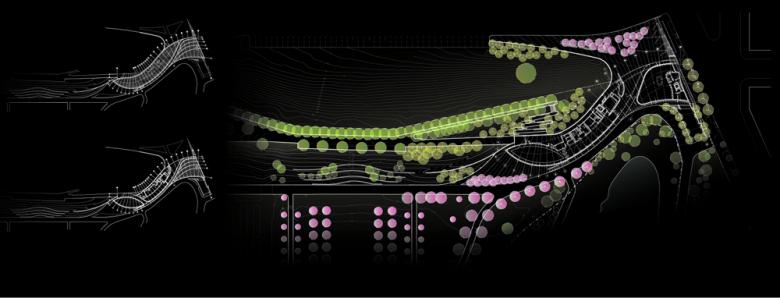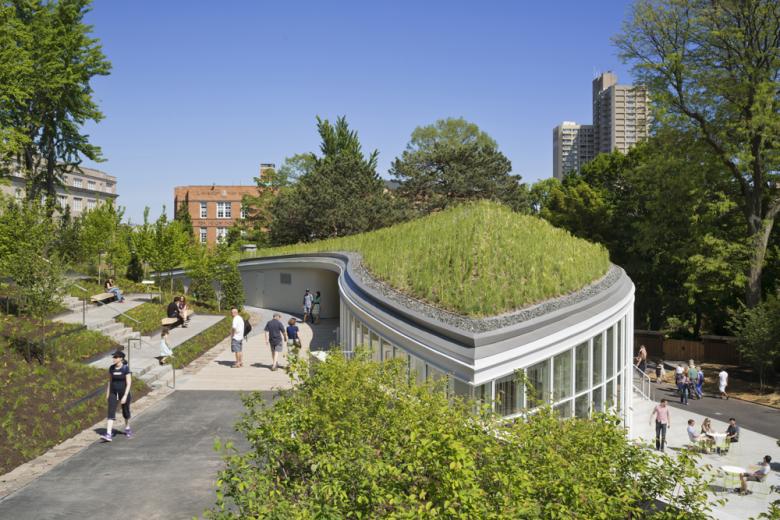Brooklyn Botanic Garden Visitor Center
Brooklyn Botanic Garden Visitor Center
28. August 2012
In May the Brooklyn Botanic Garden opened its new Visitor Center, designed by architects WEISS/MANFREDI. Partners Marion Weiss and Michael Manfredi actually live nearby, and maybe that proximity allowed them to craft a building that appreciates the existing characteristics of the place while still looking to its future. The serpentine building beautifully transitions from city to garden, all the while carefully balancing architecture and landscape to create a special hybrid. The architects answered a few questions about the project.
Garden and City Context from Washington Avenue
What were the circumstances of receiving the commission for this project?
The project commission was initiated by an invited request for proposal where we decided to question the original Brooklyn Botanic Garden Master Plan location that sited the building in the center of an existing berm abutting a parking lot. Rather than abide by the original Master Plan location we elected to propose an alternative in placing the structure towards the street of Washington Avenue giving the Garden a visible ‘gateway’ while preserving the Garden’s tall mature Ginkgo trees that lined the top of the existing berm.
View from Cherry Walk at Dusk
Can you describe your design process for the building?
Leveraging its unique context within the Olmsted-designed Brooklyn Botanic Garden, the design for the Visitor Center inverts the distinctions between building and site. Like the gardens themselves, the building is experienced cinematically and is never seen in its entirety. The serpentine form of the Visitor Center is generated by the garden’s existing pathways. Architecture, landscape, and ecology collaborate in a series of braided paths that are part landscape and part architecture. The shifting section and slow twist of the plan create a metered transformation from city to garden, with a section that changes dramatically from a freestanding urban gateway to an inhabitable earthwork whose glass-lined interior gallery is an extension of the paths through the garden.
Upper Level Garden Pathway
How does the building compare to other projects in your office, be it the same or other building types?
We continually explore the relationships between landscape, architecture and infrastructure. Our vision of a constructed site finds its place somewhere between two extremes: the modernist archetype of a purely sculptural, autonomous architecture and the architecture of camouflage, where construction is fully blended into a context. This constructed hybrid – equal parts natural, cultural, and infrastructural – is invented through the lens of geometry and topography and given measure and value through material construction, cultivation, and use.
Garden View from Ginkgo Allee
For instance, our design for the Seattle Art Museum’s Olympic Sculpture Park, which operates at a significantly larger scale than the Brooklyn Botanic Garden Visitor Center, employs parallel devices of section and topography, sequence and movement to demonstrate how a city can be reconnected to its waterfront through a dynamic landscape infrastructure that integrates art and architecture. Settings for art, ecology, and recreation are woven together and stitched into the fabric of the city to create a catalyst for new development and a nexus for an emerging community.
Garden Entry and Ticketing
How does the building relate to contemporary architectural trends, be it sustainability, technology, etc.?
The new Brooklyn Botanic Garden Visitor Center will achieve LEED Gold Certification. The sustainable design integration seeks to establish a standard for innovation in urban institutional buildings. An active education program makes these sustainable initiatives visible to the Garden’s visitors and local community.
The Visitor Center incorporates several sustainable measures that are aimed at increasing thermal efficiency by embedding the structure into an existing 20-foot sloping berm, incorporating a low-emitting fritted glass envelope designed to minimize heat gain while maximize illumination from sunlight and constructing a geoexchange system consisting of ground-source thermal wells to reduce the structure’s overall energy consumption. Additionally the project is designed with an exciting new experimental ‘living’ green roof with more than 40,000 grasses, spring bulbs and perennial wildflowers. The living roof slows and channels rainwater to a series of rain gardens that retain and filter stormwater.
Double Height Event Space
City and Garden Context Diagram
Site Axonometric
Site Plan
Pavilion Axonometric
Green Roof Palette Diagram
Inhabitable Topography and Green Roof
Further engaging a site specific approach at a larger scale, our Museum of the Earth, commissioned by the Paleontological Research Institution, engages the remarkable landforms of the upstate New York’s Finger Lakes region. The museum houses one of the nation’s largest paleontological collections and demonstrates the intrinsic relationships between geological events and biological evolution. Shifted and carved by a receding ice sheet twenty thousand years ago, the site is marked by a gradual, forty-foot slope. The design capitalizes on this rich condition, making vivid the dynamic interrelationship between biology and geology that is central to the museum’s mission.
Double Height Event Space Lecture
To make this undulating ‘living’ roof, the design utilized three-dimensionally modeling that gave measure to the 29 hollow steel tube frames used to contain infrastructure. Using the 3D modeling programs for the architecturally exposed to view steel structure allowed both design and fabrication to be seamlessly engineered and constructed.
Email interview conducted by John Hill.
Brooklyn Botanic Garden
Visitor Center
2012
Brooklyn, NY
Client
Brooklyn Botanic Garden
Architect/Site Design
WEISS/MANFREDI
Architecture/Landscape/Urbanism
New York
Design Principal
Michael A. Manfredi, FAIA
Marion Weiss, FAIA
Project Architect/Manager
Armando Petruccelli, RA
Project Architects
Hamilton Hadden, RA
Justin Kwok, LEED-AP
Michael Steiner, LEED-AP
Project Team
Christopher Ballentine
Cheryl Baxter
Michael Blasberg, RA
Paúl Duston-Muñoz
Additional Team Members
Patrick Armacost
Jeremy Babel
Caroline Emerson
Eleonora Flammina
Kian Goh
Michael Harshman
Aaron Hollis
Hanul Kim
Hyoung-Gul Kook
Lee Lim
Jonathan Schwartz
Na Sun
Jie Tian
Yoonsun Yang
Structural/Civil Engineer
Weidlinger Associates, Inc.
MEP/FP Engineer
Jaros, Baum & Bolles Consulting Engineers
Landscape
HM White Site Architecture
Lighting Designer
Brandston Partnership
Curtain Wall Consultant
R.A. Heintges Architects Consultants
Contractor
E.W. Howell
Construction Manager
LiRo Group
Architectural Exposed Steel
Canatal Industries
Architectural Concrete
J.M.R. Concrete Corp, Doka USA
Green Roof Membrane and System
Sika Sarnafil and Roofmeadow
Green Roof Planting
New York Green Roofs
Copper Roof
Firestone, Universal Services Group
Waterproofing
Carlisle
Curtain Wall
Shuco
Glazing
St. Gobain, Ecklet Glas
Precision Glass Bending
Acoustical Ceiling
Decoustics
Building Area
22,000 SF
Photos
Albert Vecerka / Esto












